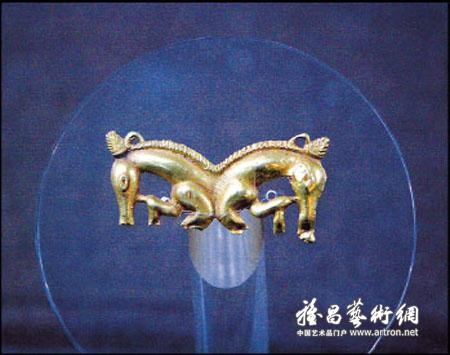
Art from the Cradle of Horsemen
2008-09-04 11:26:58 未知

A Xianbei minority gold plate with two horses from the Yuan Dynasty (1271-1368).
The Inner Mongolian grasslands produced not only legendary warrior horsemen and nomads living in harmony with nature, but also artists who created superb grassland treasures.
The Horqin Museum in Tongliao City, eastern Inner Mongolia, features a collection of porcelain and statues by artists of the Mongolian Horqin tribe. In the Mongolian language, Horqin means "people with bows and arrows."
The lush Horqin Plain, called the "cradle of the horseback group," was home to the Liao River civilization. It lay at the heart of the Eurasian Mongol Empire that stretched from the Yellow River to the Caspian Sea and the borders of Eastern Europe.
After Genghis Khan unified Mongol tribes in the early 13th century, both European and Asian arts and culture deeply influenced Mongols' lives. They found expression in ordinary objects for daily use, accessories and decoration, royal treasures and religious art.
Stone and jade carving, pottery, porcelain, bronzeware, gold and silver ornaments, Buddhist statues and other art were left as the "Horqin historical treasures" that still resonate with the essence of the vast Eurasian prairies.
Bronze stirrups, ceramic ewers, porcelain teapots and vessels, hunting tools, incense burners and more reflect the "grassland culture" through their detailing.
Here is a look at some of the treasures now on display at the Horqin Museum's Mongolian Exhibition.
(责任编辑:李丹丹)
注:本站上发表的所有内容,均为原作者的观点,不代表雅昌艺术网的立场,也不代表雅昌艺术网的价值判断。
 阿拉里奥画廊上海转型:为何要成为策展式艺术商业综合体?
阿拉里奥画廊上海转型:为何要成为策展式艺术商业综合体? 吕晓:北京画院两个中心十年 跨学科带来齐白石研究新突破
吕晓:北京画院两个中心十年 跨学科带来齐白石研究新突破 OCAT上海馆:参与构建上海艺术生态的十年
OCAT上海馆:参与构建上海艺术生态的十年 “纤维”提问2022:存在何“缓”?
“纤维”提问2022:存在何“缓”?
全部评论 (0)